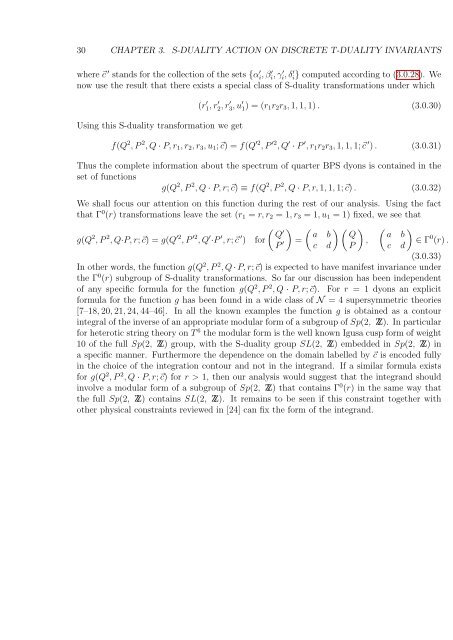PHYS08200604018 Shamik Banerjee - Homi Bhabha National ...
PHYS08200604018 Shamik Banerjee - Homi Bhabha National ...
PHYS08200604018 Shamik Banerjee - Homi Bhabha National ...
Create successful ePaper yourself
Turn your PDF publications into a flip-book with our unique Google optimized e-Paper software.
30 CHAPTER 3. S-DUALITY ACTION ON DISCRETE T-DUALITY INVARIANTS<br />
where ⃗c ′ stands for the collection of the sets {α ′ i, β ′ i, γ ′ i, δ ′ i} computed according to (3.0.28). We<br />
now use the result that there exists a special class of S-duality transformations under which<br />
Using this S-duality transformation we get<br />
(r ′ 1, r ′ 2, r ′ 3, u ′ 1) = (r 1 r 2 r 3 , 1, 1, 1) . (3.0.30)<br />
f(Q 2 , P 2 , Q · P, r 1 , r 2 , r 3 , u 1 ;⃗c) = f(Q ′2 , P ′2 , Q ′ · P ′ , r 1 r 2 r 3 , 1, 1, 1;⃗c ′ ) . (3.0.31)<br />
Thus the complete information about the spectrum of quarter BPS dyons is contained in the<br />
set of functions<br />
g(Q 2 , P 2 , Q · P, r;⃗c) ≡ f(Q 2 , P 2 , Q · P, r, 1, 1, 1;⃗c) . (3.0.32)<br />
We shall focus our attention on this function during the rest of our analysis. Using the fact<br />
that Γ 0 (r) transformations leave the set (r 1 = r, r 2 = 1, r 3 = 1, u 1 = 1) fixed, we see that<br />
g(Q 2 , P 2 , Q·P, r;⃗c) = g(Q ′2 , P ′2 , Q ′·P ( ) ( ) ( ) ( )<br />
Q ′ , r;⃗c ′ ′ a b Q a b<br />
) for<br />
P ′ =<br />
,<br />
∈ Γ 0 (r) .<br />
c d P c d<br />
(3.0.33)<br />
In other words, the function g(Q 2 , P 2 , Q · P, r;⃗c) is expected to have manifest invariance under<br />
the Γ 0 (r) subgroup of S-duality transformations. So far our discussion has been independent<br />
of any specific formula for the function g(Q 2 , P 2 , Q · P, r;⃗c). For r = 1 dyons an explicit<br />
formula for the function g has been found in a wide class of N = 4 supersymmetric theories<br />
[7–18, 20, 21, 24, 44–46]. In all the known examples the function g is obtained as a contour<br />
integral of the inverse of an appropriate modular form of a subgroup of Sp(2, Z). In particular<br />
for heterotic string theory on T 6 the modular form is the well known Igusa cusp form of weight<br />
10 of the full Sp(2, Z) group, with the S-duality group SL(2, Z) embedded in Sp(2, Z) in<br />
a specific manner. Furthermore the dependence on the domain labelled by ⃗c is encoded fully<br />
in the choice of the integration contour and not in the integrand. If a similar formula exists<br />
for g(Q 2 , P 2 , Q · P, r;⃗c) for r > 1, then our analysis would suggest that the integrand should<br />
involve a modular form of a subgroup of Sp(2, Z) that contains Γ 0 (r) in the same way that<br />
the full Sp(2, Z) contains SL(2, Z). It remains to be seen if this constraint together with<br />
other physical constraints reviewed in [24] can fix the form of the integrand.

















